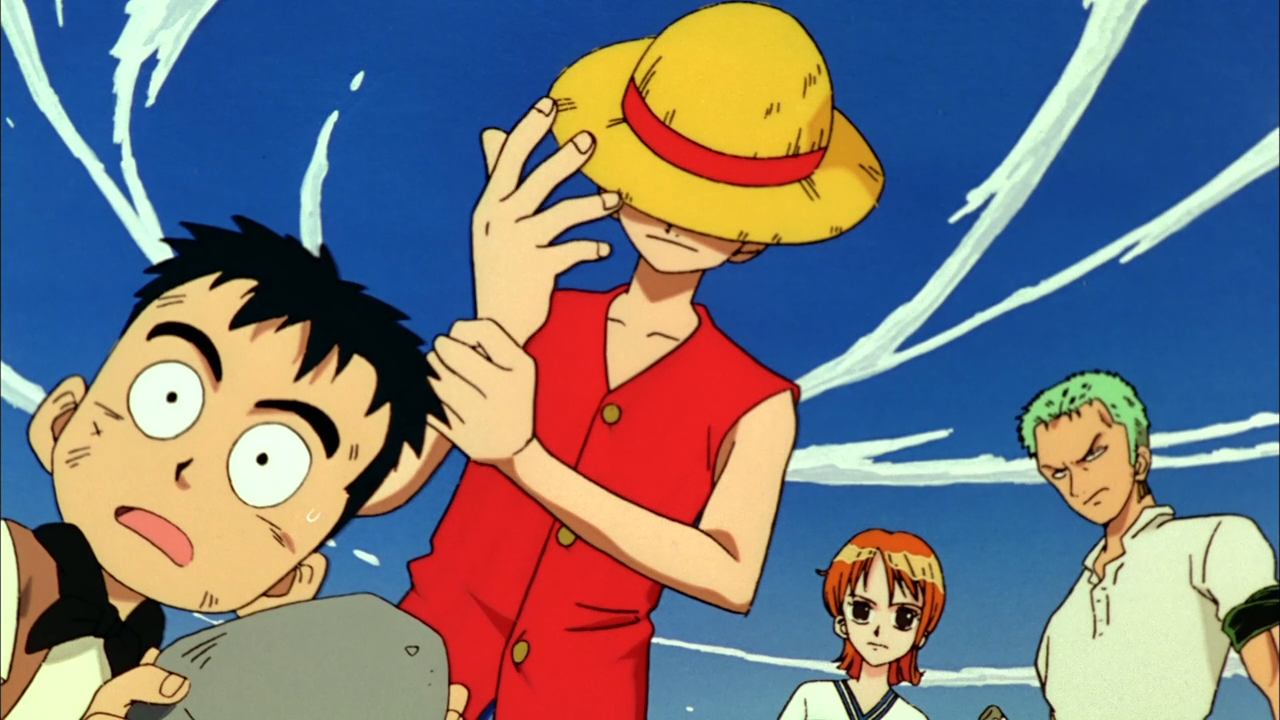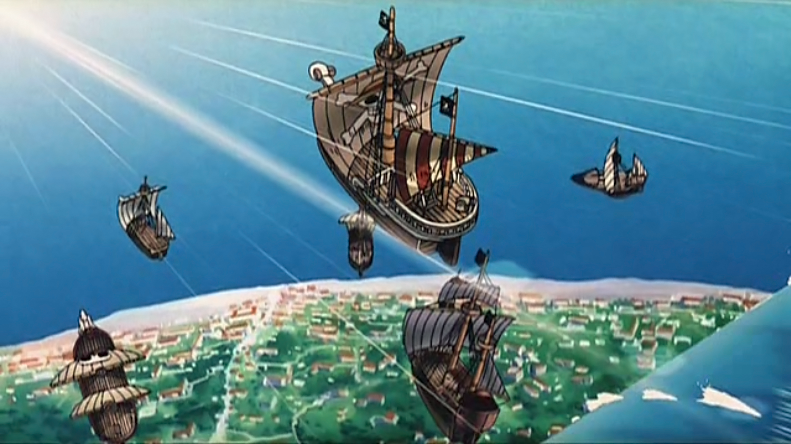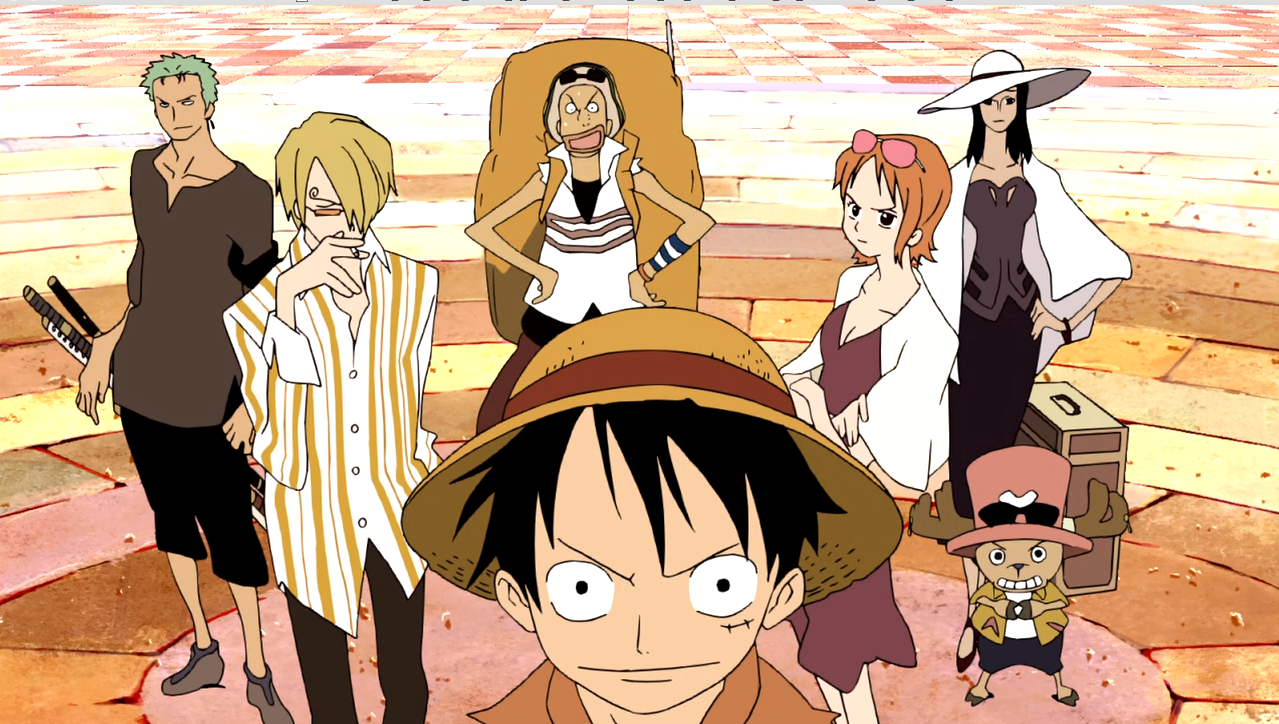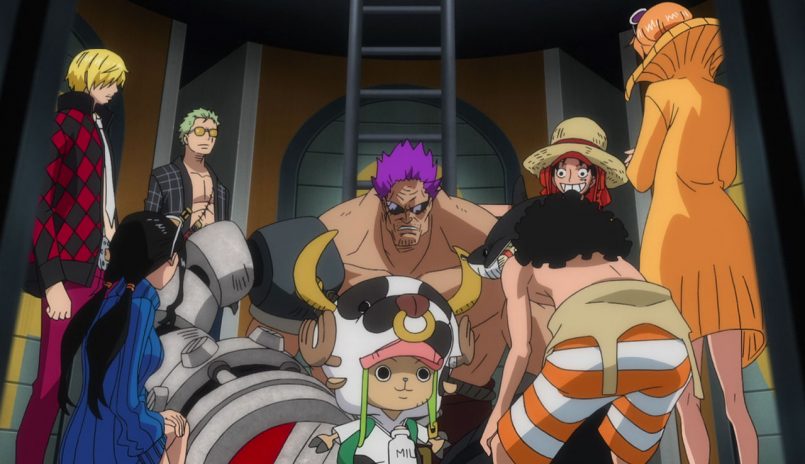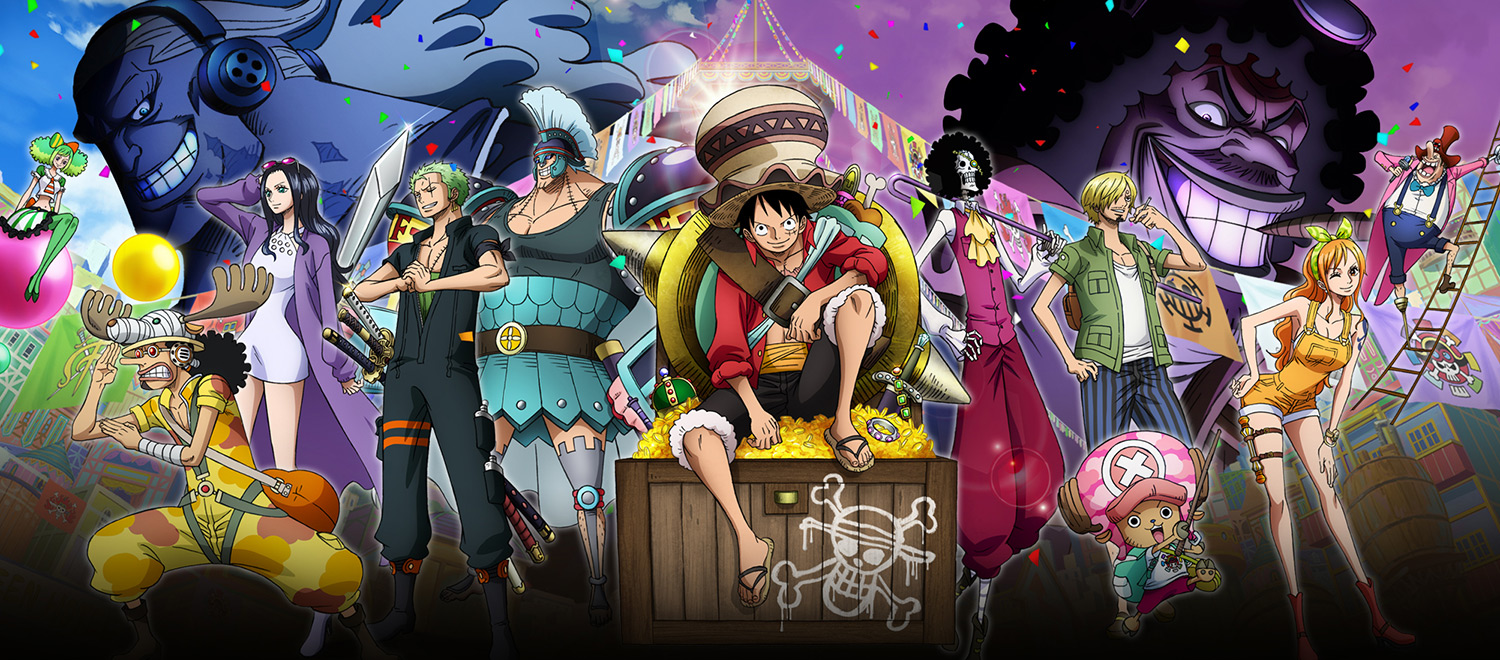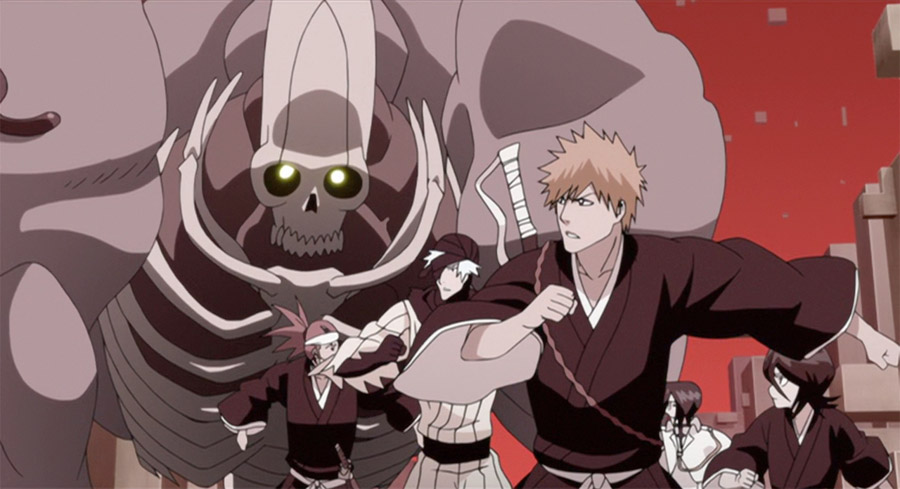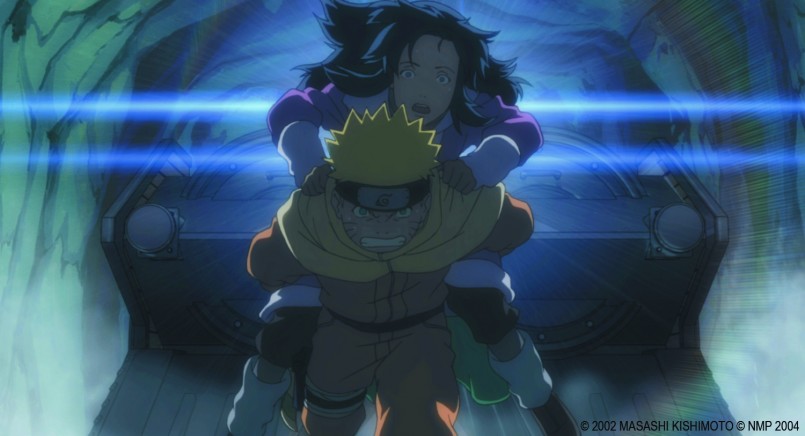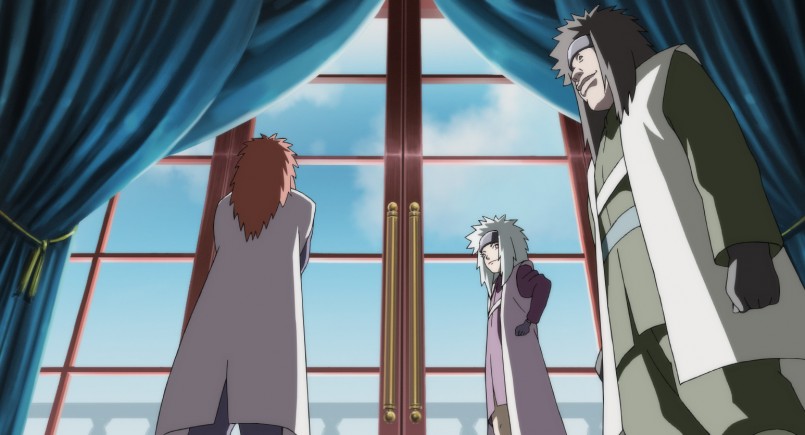Latest Addition: One Piece Film: Red
Do you have feedback, questions, movie suggestions or review copy offers? You can contact us using our Contact Page
I’ve spent more time than I care to think about watching anime movies in my life thus far. I’ve seen both astoundingly spectacular and horrifically terrible anime movies. I’m giving you the full benefit of my anime experiences in the form of this list of mini-reviews. You’ll find anime TV series movies organized below according to series and release date. Unlike the main Anime Movie Guide, the TV Series Guide (for the sake of completion) lists and reviews all of the movies released for each series instead of just listing the the very best. It is highly suggested that you read the mini-review/synopsis for each anime movie before deciding whether or not to watch it as not all TV series anime movies are created equal. As an added bonus, I’ve included notes about what episodes were airing in the respective anime TV series around the time that each movie came out so you know which episodes you should watch before seeing them to avoid possible plot-related spoilers and/or confusion.
One Piece

The first chapter of the One Piece manga hit store shelves on Aug. 24, 1997 in the weekly Shōnen Jump magazine. It took less than two years for One Piece to become a full-fledged anime series with the first episode airing on Oct. 20, 1999. Since then, One Piece has grown to be the most popular manga series of all time in Japan with over 280 million volumes sold as of 2012. One Piece follows the story of a pirate named Monkey D. Luffy and his rag-tag Straw Hat pirate crew as they set-out to help Luffy become The King of the Pirates by finding a legendary treasure called One Piece that the last Pirate King Gold Roger hid at the end of the Grand Line, a series of islands separated from the rest of the world by windless oceans that cannot be sailed. While sometimes bloody, One Piece is generally good for the whole family and has such a compelling story that you’ll likely want to start reading the manga once you’ve seen any of the anime series or movies.
One Piece (2000)
Wan Pīsu (ワンピース)
Director: Atsuji Shimizu
Last Episode Before Release: Episode 16
The first One Piece feature film is a good one, but its animation hasn’t aged very well over the last decade or so. The Straw Hat pirate crew for this movie consists only of Luffy, Zoro, Usopp, and Nami. The movie’s plot involves the Straw Hat pirates, starving for their lack of Sanji, being shanghaied by the El Drago pirates who are on their way to an island to search for the legendary treasure of the Great Gold Pirate Woonan and then getting tangled up in the search for the treasure. Fairly light as far as One Piece movies go, this is a good one to see if only to understand just how greatly One Piece has evolved over the years and enjoy a little side-story with the early Straw Hat crew.
Clockwork Island Adventure (2001)
Nejimaki-jima no Bōken (ねじまき島の冒険)
Director: Atsuji Shimizu
Last Episode Before Release: Episode 60
Sanji makes is first film appearance as a Straw Hat crew member in Clockwork Island Adventure. In just a year, One Piece’s quality of animation improved significantly, but this movie’s visuals are still dated by today’s standards, just not grossly so. The narrative follows the Straw Hat pirates as they are once again set upon by thieves and chase after their stolen pirate ship ending up at a “floating” island whose inhabitants are being oppressed by a pirate crew called the Trump Siblings. The steaks are high throughout the movie and it’s cool to see the Straw Hats in all-out battles against their various powerful and well-matched foes. This is a fine One Piece movie and definitely a recommended watch.
Chopper’s Kingdom on the Island of Strange Animals (2002)
Chinjū-tō no Choppā-ōkoku (珍獣島のチョッパー王国)
Director: Atsuji Shimizu
Last Episode Before Release: Episode 102
Adding Chopper (and specifically not Nico Robin) to the Straw Hat crew, Chopper’s Kingdom on the Island of Strange Animals is essentially both the least canonical and one of the least beloved of the One Piece movies (I still enjoy it because Chopper is my favourite character, but that’s neither here nor there). The story has the Straw Hat pirates arriving at the Island of Strange Animals only to have their ship thrown into the air and have Chopper fall overboard. Chopper is then crowned the king of the strange animals and both he and the rest of the Straw Hat crew help defend the island’s inhabitants from a treasure hunter named Count Butler and his henchmen. While less involved than pretty much all of the other One Piece movies, as the so-called “worst” of the bunch this movie is still better than some of the more common anime rabble these days. Not a bad time, but there are certainly better anime movies to watch.
Dead End Adventure (2003)
Dead End no Bōken (デッドエンドの冒険)
Director: Kōnosuke Uda
Last Episode Before Release: Episode 146
This is one of the better One Piece movies. With Nico Robin joining the Straw Hat pirates, solid animation, a good storyline, and cool movie-exclusive characters, Dead End Adventure has a lot going for it. Directed by the same person who directs the anime series, the canonical Dead End Adventure feels more like an extended and epic episode of the series than some of the other One Piece movies. The plot follows the Straw Hat pirates who are hard-up for cash as they discover and then participate in a high-stakes ship race, but the race and some of their competitors are not quite what they seem. A great jaunt with the Straw Hat crew, Dead End Adventure is certainly one of the finest One Piece movies.
The Cursed Holy Sword (2004)
Norowareta Seiken (呪われた聖剣)
Director: Kazuhisa Takenouchi
Last Episode Before Release: Episode 183
The Cursed Holy Sword uses one of the popular tropes of anime series movies, a main character going rogue for seemingly no reason. Zoro mysteriously disappears while the Straw Hat crew, who have not gained any additional members since the last movie, are restocking their ship on an island. Their search for Zoro leads them to a village on the island where Zoro, in the company of some Marines, fights Sanji and steals some powerful orbs from the village. It’s up to the Straw Hat crew to discover why Zoro has seemingly gone crazy, but it must have something to do with a Holy Sword that is possibly Cursed, right? Not the most involved One Piece movie, but with some rockin’ sword fights and some ancient curses it’s a good time none-the-less.
Baron Omatsuri and the Secret Island (2005)
Omatsuri Danshaku to Himitsu no Shima (オマツリ男爵と秘密の島)
Director: Mamoru Hosoda
Last Episode Before Release: Episode 223
Directed by the incomparable Mamoru Hosoda (of The Girl Who Leapt Through Time fame), this is by far the darkest and creepiest single piece of One Piece media. This was my favourite One Piece movie until Strong World came out in 2009. The movie has the Straw Hat crew find a message in a bottle advertising a resort called Omatsuri Island where there are all manner of relaxing and fulfilling activities tailored especially for powerful Grand Line pirates. Figuring they could use a vacation they travel to the island not knowing that it harbours one of the greatest challenges they may ever face. The highly stylized and “simplified” animation in this movie is a huge departure from its counterpart in the anime series and it adds greatly to the depiction of the tribulations that the Straw Hat crew faces on the Secret Island. The dark story and graphic violence make this an anime movie that’s definitely not for kids, but provides a very unique and extremely enjoyable ride for the rest of us. This movie is not to be missed, even if you’re unfamiliar with One Piece.
The Giant Mechanical Soldier of Karakuri Castle (2006)
Karakuri-jō no Meka Kyohei (カラクリ城のメカ巨兵)
Director: Kōnosuke Uda
Last Episode Before Release: Episode 257 (set before Episode 229)
Kōnosuke Uda’s second turn at the helm of a One Piece movie is largely a forgettable outing. The movie has a couple of mildly interesting twists, but really stands at the back of the pack of One Piece movies along with Chopper’s Kingdom on the Island of Strange Animals. The plot follows the Straw Hat Crew as they hear the legend of a priceless Golden Crown hidden on Mecha Island which is covered with myriad mechanical marvels. I don’t want to give away the plot twists, but the Crew solves riddles across the island along with some of the island’s residents to uncover a secret that most of them weren’t expecting. Not a completely terrible anime movie by most turns, this is just not one to hold one’s breath over in anticipation of watching. It’s also a good deal lighter in tone than its numerical predecessor, so no more worries for family viewing than with any other standard One Piece fare.
The Desert Princess and the Pirates: Adventures in Alabasta (2007)
Episōdo obu Arabasuta: Sabaku no Ōjo to Kaizoku-tachi
(エピソードオブアラバスタ 砂漠の王女と海賊たち)
(lit. “Episode of Alabasta: The Desert Princess and the Pirates”)
Director: Takahiro Imamura
Episodes Summarized: 92-130
This movie serves solely as a summary of the events during the Alabasta Arc of the One Piece anime with improved animation. In the Alabasta Arc the Straw Hat Pirates land on the desert island of Alabasta to find the Kingdom of Sand embroiled in a civil war due to the meddling of Crocodile, a Shichibukai (a powerful pirate working for the World Government) and leader of the criminal organization Baroque Works. Luffy and crew then try to help their new friend Vivi, the kingdom’s princess, save the island from its turmoil. Fairly minor details were either omitted or tweaked to make the story flow better in its condensed form, but nothing major enough to cause concern was changed. Unlike many anime series summary movies, though, Adventures in Alabasta‘s limited exposition makes this movie only truly enjoyable by people who are already acquainted with the One Piece series. With events occurring thick and fast, much of the movie’s value is lost on people who know nothing or very little about the series’ characters. Inexplicably the most widely available One Piece movie in North American stores, Adventures in Alabasta is a pleasant trip down memory lane for One Piece fans but is certainly the wrong place to start if you’re a newcomer to the series.
Episode of Chopper Plus: Bloom in Winter, Miracle Sakura (2008)
Episōdo Obu Choppā Purasu: Fuyu ni Saku, Kiseki no Sakura
(エピソードオブチョッパー+ 冬に咲く、奇跡の桜)
Director: Atsuji Shimizu
Episodes Embellished: 78-91
Last Episode Before Release: Episode 344
Playing on the episode summary concept from the previous year’s movie, Episode of Chopper Plus is rather an anachronistic non-canonical retelling of the Drum Island Arc from the anime series/manga wherein Tony Tony Chopper’s back story of having eaten the Human-Human devil fruit is told and he eventually joins the Straw Hat crew. The movie adds in Franky, Nico Robin and the Thousand Sunny ship, none of whom were yet part of the Straw Hat crew when the events originally took place in the series, as well as changing a number of details about the story and characters to fit its new chronological placement after the Enies Lobby Arc which ended with Episode 312. Different enough from the original arc for fans of the series (especially of Chopper) and compelling enough to stand on its own, Episode of Chopper Plus was an interesting experiment in retelling an arc from the series, but stands as one of the weaker overall One Piece movies due to its familiarity and slightly lower budget animation.
One Piece Film: Strong World (2009)
Wan Pīsu Firumu: Sutorongu Wārudo
(ワンピースフィルム ストロングワールド)
Director: Munehisa Sakai
Last Episode Before Release: Episode 429
While still non-canonical, Strong World was the first One Piece movie to be written and supervised by the series’ creator Eiichiro Oda — this was such a large departure from the preceding One Piece movies that there was huge buzz around its release. Strong World also marks several other firsts for One Piece movies including the first film appearance of Brook, the use of “One Piece Film” in the movie titles, and the tradition of having several very distinct and unique costume changes for each character throughout the movie. The plot follows the Straw Hat crew as Nami is kidnapped by a famous pirate named Golden Lion Shiki and the rest of the crew have to navigate his islands filled with huge dangerous creatures to gear up and try to get her back. A fun, unique, and often times hilarious One Piece movie, Strong World represents a sort of renaissance for the quality of One Piece’s theatrical films and is certainly one that is not to be missed.
One Piece 3D: Straw Hat Chase (2011)
Wan Pīsu Surī-Dī Mugiwara Cheisu (ONE PIECE 3D 麦わらチェイス)
Director: Hiroyuki Satoh
Last Episode Before Release: Episode 489
A fun, relatively light and short movie, One Piece 3D was double-billed with a 3D Toriko movie when it hit theatres in 2011 so it weighs in at a mere 30 minutes long. The cel-shaded 3D animation is more reminiscent of modern video games than it is of theatrical productions, but it manages to resemble the series’ traditional animation enough that it’s not overly distracting during the film’s short run time. The plot follows the Straw Hat crew as they try to get Luffy’s stolen hat back while battling their way through Marines and Sea Kings. There is not a whole lot to One Piece 3D, but it’s a fine if short foray into the third dimension for the Straw Hat crew.
One Piece Film: Z (2012)
Wan Pīsu Firumu: Zetto (ワンピースフィルム ゼット)
Director: Tatsuya Nagamine
Last Episode Before Release: Episode 576
The second One Piece film to be executive produced by Eiichiro Oda himself, One Piece Film: Z is a favourite among many One Piece fans due to its interesting and well developed new characters, heavy use of the Marine Admiralty, exceedingly high stakes, and good balance between humour and thrilling battle scenes. The film’s story follows the Straw Hat crew as they happen upon an insanely strong purple-haired ex-Marine named Z who has formed his own Neo Marines and is bent on the destruction of all pirates. The crew get some of their best-ever cinematic battles, some fun costume changes, and many Marines get their first post time-jump anime appearances — One Piece Film: Z is a great time and a must-see for fans of One Piece and action anime alike.
One Piece Film Gold (2016)
Wan Pīsu Firumu Gōrudo (ワンピースフィルムゴールド)
Director: Hiroaki Miyamoto
Last Episode Before Release: Episode 750
Still graciously produced by Eiichiro Oda, One Piece Film Gold is just as flashy and full of spectacle as the name would suggest. Featuring some of the very best animation that One Piece has ever had (second only in my mind to Baron Omatsuri and the Secret Island), One Piece Film Gold follows the Straw Hat crew as they visit an enormous casino/resort ship called the Gran Tesoro which is run as an independent country by megalomaniac and devil fruit user Gild Tesoro. The crew is welcomed on the ship to compete in numerous challenges of skill and chance to rack up enough bellies/berries to give Nami heart palpitations. At a full 120 minutes, this is the longest One Piece movie yet, and while you can feel its length as the pacing lulls in a couple of places, One Piece Film Gold is ultimately very much worth the ride and is a dazzling spectacle of an anime movie whether you’re a One Piece novice or (gold) card carrying expert.
One Piece: Stampede (2019)
Wan Pīsu Sutanpīdo (ワンピーススタンピード)
Director: Takashi Otsuka
Last Episode Before Release: Episode 896
Following the tradition of aptly named One Piece movies, One Piece: Stampede really is a cavalcade of the dozens upon dozens of characters and factions that had been introduced in the anime up to its release. The plot follows the Straw Hat crew as they (and basically everyone else ever including the Marines, CP9, most of the Seven Warlords, most of the Worst Generation pirate crews and the Revolutionary Army) arrive at Delta Island for a Pirate Fest thrown by Buena Festa, a pirate captain long thought dead. Turns out that a great treasure is up for the offering and Buena Festa had ulterior motives in gathering everyone in one place that could possibly end the Golden Age of Piracy. Chaotic, indulgent and messy, One Piece: Stampede sometimes feels like someone dumped a huge tub of One Piece action figures in a pile and made them fight a kaiju, but those unusual character pairings and opportunities for big flashy fights make the movie work in spite of its overabundance. Dedicated One Piece fans will get the most from this movie as the huge cast of characters blaze by, but it’s entertaining and engaging on the whole and a good popcorn movie if nothing else.
One Piece Film: Red (2022)
Wan Pīsu Firumu Reddo (ワンピース フィルム レッド)

Director: Gorō Taniguchi
Last Episode Before Release: Episode 1027
After the chaotic and bombastic One Piece: Stampede (and a global pandemic), One Piece was in need of a slightly different kind of movie and One Piece Film: Red delivers on all levels. The story sees the One Piece crew attending the first concert of a huge Taylor Swift-style J-pop idol named Uta. It turns out that Luffy knows her very well, but all may not be as it seems in the stadium crowded with people from all corners of the One Piece world. One Piece Film: Red features seven original songs sung by a similarly mysterious real-world J-pop idol Ado along with accompanying music video sections that are woven into the film’s narrative. While a musical movie is exceedingly rare for shōnen anime series, it actually works remarkably well here, and the songs written / arranged by big contemporary names in the J-pop world are all pretty great. While it’s a departure for both One Piece and anime series movies in general, One Piece Film: Red is a riveting musical adventure and among the best One Piece movies for both action and narrative. Like all One Piece films, Red is non-canonical, but Uta is now a canonical One Piece character and I think the series is even better for it.
My Hero Academia

The first chapter of the My Hero Academia manga, created by Kōhei Horikoshi, debuted in July 2014 in the weekly Shōnen Jump magazine. Studio Bones’ anime TV series for My Hero Academia then premiered in April 2016 and has only grown in popularity since. In the world of My Hero Academia, they say that around 80% of people have superpowers called Quirks, but the protagonist Izuku Midoriya was born without any. While dreaming of being a super-powered hero, Izuku meets one of the greatest heroes in the world, All Might, who sees potential in him and passes down his special Quirk that allows it to be passed to others. The story follows Izuku (hero name: Deku) as he attends U.A. High School which is training the next generation of heroes and his quest to become the greatest hero in the world. My Hero Academia is comparable to the likes of Naruto, One Piece and other shonen action anime in terms of graphic content, so it’s probably not for super small children, but can be generally recommended for everyone else who is looking for some anime superhero action.
My Hero Academia: Two Heroes (2018)
Boku no Hīrō Academia THE MOVIE: Futari no Hīrō
(僕のヒーローアカデミア THE MOVIE ~2人の英雄(ヒーロー)~)
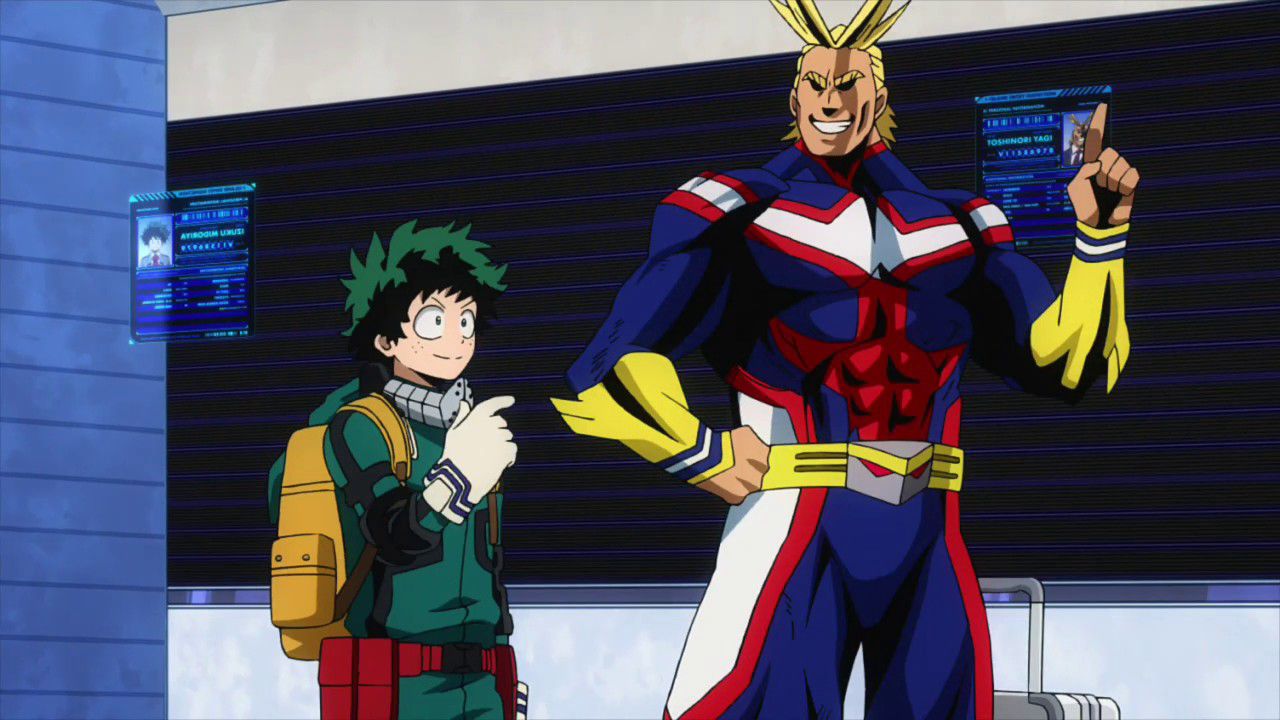
Director: Kenji Nagasaki
Last Episode Before Release: Episode 54
My Hero Academia’s first film is a solid entry point for anyone new to the series. With a good helping of exposition, character introductions and character interactions, the heart of the series permeates and uplifts what would otherwise be a fairly standard anime TV series movie. The plot follows Deku as he and All Might are invited by All Might’s former partner, Prof. David Shield, to the public opening of an artificial island where scientists from the world over study the superpowers known as Quirks. Many of Deku’s classmates also happened to make their way to the island, which is helpful when a group of villains takes the island hostage leading to a The Raid or Judge Dredd-style siege on the island’s control tower as Deku and crew try to save everyone. While there is nothing particularly surprising or original about the components of Two Heroes, the movie as a whole is a great time that showcases and celebrates everything that makes My Hero Academia special.
My Hero Academia: Heroes Rising (2019)
Boku no Hīrō Akademia THE MOVIE: Hīrōzu: Raijingu
(僕のヒーローアカデミア THE MOVIE ヒーローズ:ライジング)

Director: Kenji Nagasaki
Last Episode Before Release: Episode 72
Much in the way the first My Hero Academia film was about celebrating the series, the second film is about pushing it to its limits — putting Deku and his classmates up against amazingly powerful villains. In Heroes Rising, we see the heroes of Class 1-A given their provisional hero licenses and sent to Nabu Island off of the coast of the mainland to temporarily serve as the island’s police/emergency/busywork services because their hero in residence recently retired. Their idyllic field training is brought to a screeching halt when a group of villains led by a mysterious man named Nine (shown above) who has the power to absorb and steal others’ Quirks show up and start tearing the island apart looking for someone. This movie is chronologically set in an interesting time for an anime TV series movie, being set well in the future of the current anime episodes, between the two latest arcs of the manga. While perhaps confusing for fans of the anime that are not acquainted with the manga, in practice it serves the movie well allowing the heroes to showcase the utmost of their abilities in dazzling ways. The dazzle does come at the expense of more character-focused moments that the first movie was good for, but for my money, this is more than made up for by the over-the-top action. Featuring some of the series’ best fights and ones that easily stand toe-to-toe with the best from the likes of larger series movies such as One Piece and Naruto, Heroes Rising is a great action movie and definitely the best My Hero Academia movie yet.

The first volume of the Bleach manga, created by Tite Kubo, debuted in August of 2001 in the weekly Shōnen Jump magazine. Three years later, Bleach took to the TV screens of Japan with its first episode airing on Oct. 5, 2004. Even though Bleach is one of Shonen Jump’s most popular manga and anime series, the anime came to an end abruptly in March 2012. Bleach follows the story of a teenager named Kurosaki Ichigo and how he is unexpectedly thrust into a complex spiritual world parallel to our own where squads of shinigami (also called Soul Reapers) battle demons called Hollows and free the souls of the departed to pass on to a place called Soul Society. Bleach is often quite bloody and dark, so it’s not generally great for families, but has a huge cast of very complicated and well-developed characters that are sure to enthrall more mature anime viewers.
Bleach: Memories of Nobody (2006)
Director: Noriyuki Abe
Last Episode Before Release: Episode 107
The first Bleach movie is a stand-out film for many reasons: the movie’s primary original character, a mysterious female shinigami named Senna, is thoroughly endearing and easily stands among the best Bleach characters, the story is both meaningful and touching, and it’s both visually and aurally well-produced. The movie’s story centers around Senna’s mysterious appearance along with strange Hollow-like creatures called Blanks and how Ichigo attempts to protect her from a group of shinigami called the Dark Ones. Even though it’s a non-canonical anime movie, so you know from the get-go that nothing too serious can happen, the movie still carries an uncharacteristically deep emotional weight and is a must-see for anime and Bleach fans alike.
Bleach: The DiamondDust Rebellion (2007)
Gekijōban Burīchi Za Daiyamondo Dasuto Reberion Mō Hitotsu no Hyōrinmaru
(劇場版BLEACH The DiamondDust Rebellion もう一つの氷輪丸)
(lit. Bleach: The DiamondDust Rebellion, Another Hyōrinmaru)
Director: Noriyuki Abe
Last Episode Before Release: Episode 153 (but best viewed after Episode 167)
Like One Piece’s The Cursed Holy Sword, The DiamondDust Rebellion features a popular character, in this case Tōshirō Hitsugaya (the captain of the Tenth Division), suddenly going rogue when a very powerful artifact called the King’s Seal is stolen under his watch. To avoid spoilers, I won’t discuss the plot any further other than to say that it involves some interesting details of Hitsugaya’s past. As in Memories of Nobody, a few interesting elements are added to the Bleach mythos through this movie, and while it’s not quite as emotionally heavy-handed as its predecessor, The DiamondDust Rebellion is a great anime movie, particularly for fans of Hitsugaya.
Bleach: Fade to Black (2008)
Burīchi Fade to Black Kimi no Na o Yobu (BLEACH Fade to Black 君の名を呼ぶ)
(lit. Bleach: Fade to Black, I Call Your Name)
Director: Noriyuki Abe
Last Episode Before Release: Episode 198
Another great Bleach movie. In Fade to Black, two mysterious people with an odd scythe erase everyone in Soul Society’s memories of Rukia’s existence, and by extension their memories of Ichigo. Ichigo and Kon soon snap back to normal and set out to try to figure out why Rukia was spirited away. Fade to Black is filled with fanservice, insofar as you get to see Ichigo once again battle many of the captains and vice-captains of the Gotei 13, and is generally all the more awesome for it. You get to learn even more about Rukia’s past and have a nice showy narrative to enjoy in the mean time. An enjoyable ride throughout, just make sure you know a thing or two about Bleach before watching it, otherwise the plethora of characters flashing by will be pretty overwhelming.
Bleach: Hell Verse (2010)
Burīchi Jigoku-Hen (劇場版BLEACH 地獄篇) (lit. Bleach: Inferno or Bleach: Hell Chapter)
Director: Noriyuki Abe
Last Episode Before Release: Episode 299
The most recent (and possibly final) Bleach movie is also possibly the best of a very good bunch. A group of strange warriors seemingly break out of hell itself to force Ichigo into helping them escape their eternal torment by bringing his sisters Karin and Yuzu down with them, raising the steaks quite high and definitely making the battle more personal for Ichigo than in the previous films. Tite Kubo was more personally involved with the production of this movie than its predecessors, and it really shows. Kubo’s unique humour and charm permeates the narrative throughout and makes this feel much more rooted in the spirit of the manga series than the movies and filler episodes generally do. With far and away the best audio and visuals yet attained in any single Bleach anime, a high-stakes story, and further expansion of the Bleach mythos regarding hell, this movie is not to be missed by any Bleach fan. To avoid spoilers, though, make sure you at the very least make it up to around episode 273 (preferably 299, the last episode before the movie was released, just to be safe) before watching Hell Verse.

Masashi Kishimoto’s Naruto manga premiered in its full form in the November 1999 issue of the weekly Shōnen Jump magazine and October 3, 2002 saw the release of the ever-popular anime series adaptation of the manga. The Naruto manga is one of the best-selling manga series of all time with 126.5 million volume copies sold in Japan alone. Naruto tells the tale of a young ninja named Uzumaki Naruto as he grows up in the Hidden Leaf Village (Konoha), discovers his true powers/talents, develops both friendships and nemeses, and tries to deal with the destructive spirit of a Nine-tailed Demon Fox that was sealed in him soon after his birth leaving him an orphan and pariah. His main goal in life is to become the Hokage (leader of Konoha) to prove to everyone his inherent worth and protect those that are dear to him. The anime series aired until February 8, 2007 when it was then replaced a week later by Naruto Shippūden to highlight the time-jump that occurs in the manga series. Three movies aired under the Naruto banner, with the remaining Naruto movies coming after the switch to Naruto Shippūden. While sometimes quite gory and dark, Naruto has an excellent sense of humour and is popular among both kids and adults for its large cast of characters spanning several generations as well as its eventually quite weighty and complex plot.
Naruto the Movie: Ninja Clash in the Land of Snow (2004)
Gekijōban Naruto Daikatsugeki! Yukihime Ninpōchō dattebayo!!
(劇場版 NARUTO 大活劇! 雪姫忍法帖だってばよ!!)
(lit. “Great Action Scene! Snow Princess’ Book of Ninja Arts”)
Director: Tensai Okamura
Last Episode Before Release: Episode 97 (takes place after Episode 101)
The first Naruto movie delivered exactly what the viewing public wanted to see from a big budget theatrical Naruto release: interesting one-off characters, improved animation, an decently interesting plotline, and plenty of action. The narrative follows Team Kakashi (consisting of Naruto, Sakura, Sasuke, and their teacher Kakashi) as they travel to the Land of Snow to serve as bodyguards for an actress named Yukie Fujikaze who has secret reasons for playing that country’s Princess Fūn in movies. Naruto and crew try to protect Yukie from powerful assailants and a grand time is had by all. Ninja Clash in the Land of Snow is one of the more accessible and enjoyable pieces of Naruto media even if you aren’t acquainted with the series’ complex lore, so it’s worth checking out even if you’ve only seen Naruto on backpacks and store displays.
Naruto the Movie: Legend of the Stone of Gelel (2005)
Daigekitotsu! Maboroshi no Chiteiiseki Dattebayo (大激突!幻の地底遺跡だってばよ)
(lit. “Great Clash! The Illusionary Ruins at the Depths of the Earth”)
Director: Hirotsugu Kawasaki
Last Episode Before Release: Episode 145 (takes place after Episode 160)
The first Naruto movie left expectations high for the second, but Legend of the Stone of Gelel fell a bit short of its predecessor. The story follows Naruto, Shikamaru, and Sakura as they get caught up in an age-old battle between the Sand Ninja (led by Gaara) and a clan of heavily armoured warriors over possession of a powerful Gelel Stone. Feeling more like an elongated average-quality episode than a truly epic movie, the Legend of the Stone of Gelel is simply a lot less focused and memorable than many other anime series movies in spite of its nicely improved animation and sound quality. If you watch it you’ll see why it was never given a theatrical release in North America, which is not to say that it’s actively bad but rather just the definition of “alright”.
Naruto the Movie: Guardians of the Crescent Moon Kingdom (2006)
Dai Kōfun! Mikazuki-jima no Animaru Panikku Dattebayo!
(大興奮!みかづき島のアニマル騒動だってばよ!)
(lit. “Great Excitement! The Animal Panic of Crescent Moon Island!”)
Director: Toshiyuki Tsuru
Last Episode Before Release: Episode 195 (takes place after Episode 196)
Coming off the heels of a mildly disappointing second movie you’d think that the people over at Studio Pierrot would have been scrambling to pull up their socks and come back at full force for the third. You’d think so, but in this case you couldn’t be more wrong. Easily the very worst Naruto movie yet created, the entire first half of Guardians of the Crescent Moon Kingdom is even worse than the abysmal “Naruto uses his ninja powers to make the tastiest ramen (yes this actually happened in Episode 168)”-level of filler that was airing on Japanese television at the time. The first time I watched as Naruto, Kakashi, Sakura, and Rock Lee escorted the spoiled prince of the Land of the Moon and a circus full of animals across the sea I couldn’t believe I was watching something actually produced as a serious Naruto movie. The action picks up a bit in the film’s second half, but not nearly enough to make up for the sins of the first half. So, watch it if you absolutely must, but Guardians of the Crescent Moon Kingdom really is just about as bad as anime TV series movies come. Thank goodness for the much-needed Shippuden reboot.

Naruto Shippūden (Hurricane Chronicles) began airing on February 15, 2007 to highlight the two and a half year time jump in the series’ narrative since the end of the original Naruto series the week before. (It’s worthwhile to note that One Piece experienced a similar time jump with no effect to the anime series’ official name, so the utility of such a move is debatable.) Naruto Shippūden sees Uzumaki Naruto return to Konoha after training with a legendary ninja named Jiraiya to regroup with his similarly matured and strengthened allies to continue their quest in trying to retrieve their erstwhile comrade Uchiha Sasuke from his allegiance with an evil ninja named Orochimaru. Additionally, a shadowy group of elite renegade ninjas called Akatsuki have been capturing jinchūriki (people with the tailed demon-beasts sealed within them) to harvest them and they’re coming after Naruto next. Generally even darker than its direct predecessor, Naruto Shippūden manages to raise the stakes on most fronts keeping the story engaging while allowing the viewers to enjoy seeing powered-up versions of the characters that were introduced in the original Naruto series.
Reviews coming soon:
Naruto Shippuden the Movie (2007)
Gekijōban Naruto Shippūden (劇場版NARUTO−ナルト− 疾風伝)
Naruto Shippuden the Movie: Bonds (2008)
Gekijōban Naruto Shippūden: Kizuna (劇場版 NARUTO−ナルト− 疾風伝 絆)
Naruto Shippuden the Movie: The Will of Fire (2009)
Gekijōban NARUTO Shippūden Hi no Ishi o Tsugu Mono
(劇場版 NARUTO-ナルト-疾風伝 火の意志を継ぐ者)
Naruto Shippuden the Movie: The Lost Tower (2010)
Gekijōban Naruto Shippūden: Za Rosuto Tawā
(劇場版 NARUTO-ナルト-疾風伝 ザ・ロストタワー)
Naruto the Movie: Blood Prison (2011)
Gekijōban Naruto: Buraddo Purizun (劇場版 NARUTO-ナルト- ブラッド・プリズン)
Road to Ninja: Naruto the Movie (2012)
(劇場版NARUTO-ナルト-ROAD TO NINJA)
The Last: Naruto the Movie (2014)
(ザ・ラスト‐ナルト・ザ・ムービー‐)
Boruto: Naruto the Movie (2015)
(ボルト‐ナルト・ザ・ムービー‐)

Detective Conan (as it will be referred to hereafter instead of the localized “Case Closed”) is one of the oldest ongoing anime series featured in this guide. Written by Gosho Aoyama, the Detective Conan manga first appeared in Shogakukan’s Weekly Shōnen Sunday on January 19, 1994. The anime adaptation began airing on January 8, 1996 and has since earned the title of the sixteenth longest running anime series ever with nearly 700 episodes having aired as of early 2013. The series’ plot follows a 17-year-old prodigy detective named Kudo Shinichi who is forcefully fed an experimental poison that ends up transforming his body into that of a child instead of killing him. Shinichi then adopts the alias of Edogawa Conan to hide his identity from the Black Organization that tried to kill him while moving in with his pseudo-girlfriend Ran and her incompetent private investigator father Mouri Kogoro and enrolling in an elementary school to further complete his disguise. With the help of Prof. Hiroshi (one of the only people that know his true identity) and a group of children from the elementary school who call themselves the “Junior Detective League”, Conan goes about solving mysteries vicariously for Kogoro while trying to amass enough evidence to take down the Black Organization and find a cure for his diminutive condition. The mysteries featured in the manga, series, and movies are usually quite well-written and can often leave the viewer guessing right up to the very end. While cases like murders and thefts are a common theme, the show tends to stay on the light side making it usually just fine for family viewing without sacrificing the quality of the cases.
Detective Conan: The Time Bombed Skyscraper (1997)
Meitantei Conan: Tokei-jikake no Matenrō (名探偵コナン 時計じかけの摩天楼)
Director: Kenji Kodama
Last Episode Before Release: Episode 54
Even though it’s fairly easy to figure out whodunnit in Detective Conan’s theatrical debut, there’s no denying that it’s an exciting high-stakes movie. While the peril in any anime TV series movie can usually be dismissed outright because of their non-canonical nature, if you want to actually enjoy the movies it’s best just to suspend your disbelief and enjoy the narrative for what it is; this is especially true for Detective Conan movies. In The Time Bombed Skyscraper, Conan’s friends (and the public at large) are systematically put in very serious danger as a mysterious bomber challenges him to find/disarm bombs placed around the city. The charm in this movie lies in the cat and mouse battle of wits between Conan and the bomber instead of purely guessing at the bomber’s identity. The plot/gadget summary provided at the beginning of each Detective Conan movie makes this solid entry as good of a place as any to get acquainted with the series and once you get familiar with it it’ll surely become one of your favourites.
Detective Conan: The Fourteenth Target (1998)
Meitantei Conan Jūyon banme no Tagetto (名探偵コナン 14番目の標的)
Director: Kenji Kodama
Last Episode Before Release: Episode 97
Considerably more complex than its predecessor, The Fourteenth Target is one of the more enjoyable Detective Conan movies. The story involves a series of murders/attempted murders of people linked to Mouri Kogoro (and therefore often close to Conan) following their numeric relation to a suit from a deck of playing cards. If you don’t have a good grasp of how Japanese characters are formed and watch this movie with subtitles, the connection between the characters and their corresponding playing cards will probably be confusing. If you think this would be unacceptable I recommend watching the Case Closed dub instead as these connections, while even more tenuous, were changed to make sense in English. The over-arcing mystery is harder to solve than the one in The Time Bombed Skyscraper even though the association with people close to Conan is similar, and it may well keep you guessing up to the end. A good example of a competent anime mystery movie, The Fourteenth Target is not a Detective Conan movie that you’ll want to miss.
Reviews coming soon:
Detective Conan: The Last Wizard of the Century (1999)
Meitantei Conan Seikimatsu no Majutsushi (名探偵コナン 世紀末の魔術師)
Detective Conan: Captured in Her Eyes (2000)
Meitantei Conan Hitomi no Naka no Ansatsusha (名探偵コナン 瞳の中の暗殺者)
Detective Conan: Countdown to Heaven (2001)
Meitantei Conan Tengoku e no Kauntodaun (名探偵コナン 天国へのカウントダウン)
Detective Conan: The Phantom of Baker Street (2002)
Meitantei Conan Beikā Sutorīto no Bōrei (名探偵コナン ベイカー街の亡霊)
Detective Conan: Crossroad in the Ancient Capital (2003)
Meitantei Conan Meikyū no Kurosurōdo (名探偵コナン 迷宮の十字路)
Detective Conan: Magician of the Silver Sky (2004)
Meitantei Conan Gin-yoku no Majishan (名探偵コナン 銀翼の奇術師)
Detective Conan: Strategy Above the Depths (2005)
Meitantei Conan Suiheisenjō no Sutoratejī (名探偵コナン 水平線上の陰謀)
Detective Conan: The Private Eyes’ Requiem (2006)
Meitantei Conan Tantei-tachi no Requiem (名探偵コナン 探偵たちの鎮魂歌)
Detective Conan: Jolly Roger in the Deep Azure (2007)
Meitantei Conan Konpeki no Jorī Rojā (名探偵コナン 紺碧の棺)
Detective Conan: Full Score of Fear (2008)
Meitantei Conan Senritsu no Furu Sukoa (名探偵コナン 戦慄の楽譜)
Detective Conan: The Raven Chaser (2009)
Meitantei Conan Shikkoku no Chaser (名探偵コナン 漆黒の追跡者)
Detective Conan: The Lost Ship in the Sky (2010)
Meitantei Conan Tenkuu no Rosuto Shippu (名探偵コナン 天空の難破船)
Detective Conan: Quarter of Silence (2011)
Meitantei Conan Chinmoku no Kwōtā (名探偵コナン 沈黙の15分)
(lit. “Detective Conan: 15 Minutes of Silence”)
Detective Conan: The Eleventh Striker (2012)
Meitantei Conan Jūichi Ninme no Sutoraikā (名探偵コナン 11人目のストライカー)
Detective Conan: Private Eye in the Distant Sea (2013)
Meitantei Conan: Zekkai no Puraibēto Ai (名探偵コナン 絶海の探偵)
Lupin the 3rd vs. Detective Conan: The Movie (2013)
Rupan Sansei Bāsasu Meitantei Konan The Movie (ルパン三世VS名探偵コナン The Movie)
Detective Conan: Dimensional Sniper (2014)
Meitantei Conan Ijigen no Sniper (名探偵コナン 異次元の狙撃手)
Detective Conan: Sunflowers of Inferno (2015)
Meitantei Conan: Gōka no Himawari (名探偵コナン 業火の向日葵)
Detective Conan: The Darkest Nightmare (2016)
Meitantei Konan: Junkoku no Naitomea (名探偵コナン 純黒の悪夢)
Detective Conan: Crimson Love Letter (2017)
Meitantei Konan: Kara Kurenai no Rabu Retta (名探偵コナン から紅の恋歌)
Detective Conan: Zero’s Enforcer (2018)
Meitantei Konan: Zero no Shikkounin (名探偵コナン ゼロの執行人)
Detective Conan: The Fist of Blue Sapphire (2019)
Meitantei Konan: Konjō no Fisuto (名探偵コナン 紺青の拳)
Detective Conan: The Scarlet Bullet (2021)
Meitantei Conan: Hiiro No Dangan (名探偵コナン 緋色の弾丸)
Detective Conan: The Bride of Halloween (2022)
Meitantei Conan: Harō~in no Hanayome (名探偵コナン ハロウィンの花嫁)


